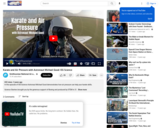
Astronaut Michael Good demonstrates how air pressure can help your karate skills.
- Subject:
- Physical Science
- Material Type:
- Activity/Lab
- Provider:
- National Air and Space Museum
- Author:
- National Air and Space Museum
- Date Added:
- 09/02/2022

Astronaut Michael Good demonstrates how air pressure can help your karate skills.
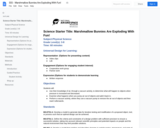
Use their knowledge of air, through a vacuum activity, to determine what will happen to objects when pressure is increased and decreased.
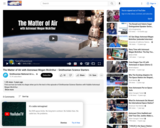
Find out how air holds its shape when put to the test in this episode of Smithsonian Science Starters with Hubble Astronaut Megan McArthur.
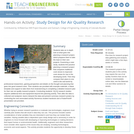
Students take an in-depth look at what goes into planning a research project, which prepares them to take the lead on their own projects. Examining a case study, students first practice planning a research project that compares traditional cook stoves to improved cook stoves for use in the developing world. Then they compare their plans to one used in the real-world by professional researchers, gaining perspective and details on the thought and planning that goes into good research work. Then students are provided with example materials, a blank template and support to take them from brainstorming to completing a detailed research plan for their own air quality research projects. Conducting students’ AQ-IQ research studies requires additional time and equipment beyond this planning activity. Then after the data is collected and analyzed, teams interpret the data and present summary research posters by conducting the next associated activity Numerous student handouts and a PowerPoint® presentation are provided.

Using a household fan, cardboard box and paper towels, student teams design and build their own evaporative cooler prototype devices. They learn about the process that cools water during the evaporation of water. They make calculations to determine a room's cooling load, and thus determine the swamp cooler size. This activity adds to students' understanding of the behind-the-scenes mechanical devices that condition and move air within homes and buildings for human health and comfort.
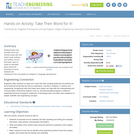
Students learn how scientific terms are formed using Latin and Greek roots, prefixes and suffixes, and on that basis, learn to make an educated guess about the meaning of a word. Students are introduced to the role played by metaphor in language development.
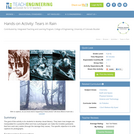
The goal of this activity is for students to develop visual literacy. They learn how images are manipulated for a powerful effect and how a photograph can make the invisible (pollutants that form acid rain) visible (through the damage they cause). The specific objective is to write captions for photographs.

Design, operation, and management of traffic flows over complex transportation networks are the foci of this course. It covers two major topics: traffic flow modeling and traffic flow operations. Sub-topics include deterministic and probabilistic models, elements of queuing theory, and traffic assignment. Concepts are illustrated through various applications and case studies. This is a half-term subject offered during the second half of the semester.
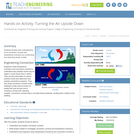
Students develop their understanding of air convection currents and temperature inversions by constructing and observing simple models.
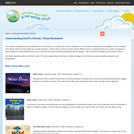
This list of children's books recommends nonfiction titles that supplement basic information found in lessons and activities of this themed issue of the online magazine Beyond Weather and the Water Cycle. The books are grouped by topic -- water, weather and climate, and atmosphere. Each book is described by its content, reading level, and possible uses in the classroom. Covers are pictured. The online magazine is produced for elementary school teachers and is structured around the essential principles of climate sciences and climate literacy.
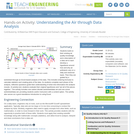
Students build on their existing air quality knowledge and a description of a data set to each develop a hypothesis around how and why air pollutants vary on a daily and seasonal basis. Then they are guided by a worksheet through an Excel-based analysis of the data. This includes entering formulas to calculate statistics and creating plots of the data. As students complete each phase of the analysis, reflection questions guide their understanding of what new information the analysis reveals. At activity end, students evaluate their original hypotheses and “put all of the pieces together.” The activity includes one carbon dioxide worksheet/data set and one ozone worksheet/data set; providing students and/or instructors with a content option. The activity also serves as a good standalone introduction to using Excel.
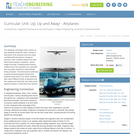
The airplanes unit begins with a lesson on how airplanes create lift, which involves a discussion of air pressure and how wings use Bernoulli's principle to change air pressure. Next, students explore the other three forces acting on airplanes thrust, weight and drag. Following these lessons, students learn how airplanes are controlled and use paper airplanes to demonstrate these principles. The final lessons addresses societal and technological impacts that airplanes have had on our world. Students learn about different kinds of airplanes and then design and build their own balsa wood airplanes based on what they have learned.

Learn about how the spirals of air that trail off the tips of an airplane's wings also contribute to drag.
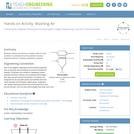
Students observe and discuss a simple model of a wet scrubber to understand how this pollutant recovery method functions in cleaning industrial air pollution.
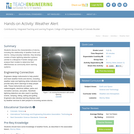
Students discuss the characteristics of storms, including the relationship of weather fronts and storms. Using everyday materials, they develop models of basic lightning detection systems (similar to a Benjamin Franklin design) and analyze their models to determine their effectiveness as community storm warning systems.
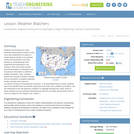
Students are introduced to some essential meteorology concepts so they more fully understand the impact of meteorological activity on air pollution control and prevention. First, they develop an understanding of the magnitude and importance of air pressure. Next, they build a simple aneroid barometer to understand how air pressure information is related to weather prediction. Then, students explore the concept of relative humidity and its connection to weather prediction. Finally, students learn about air convection currents and temperature inversions. In an associated literacy activity, students learn how scientific terms are formed using Latin and Greek roots, prefixes and suffixes, and are introduced to the role played by metaphor in language development. Note: Some of these activities can be conducted simultaneously with the air quality activity (What Color Is Your Air Today?) of Air Pollution unit, Lesson 1.
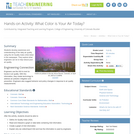
Students develop awareness and understanding of the daily air quality using the Air Quality Index (AQI) listed in the newspaper. They explore what engineers can do to help reduce poor air quality.
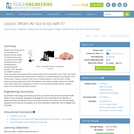
Students are introduced to the concepts of air pollution and air quality. The three lesson parts focus on the prerequisites for understanding air pollution. First, students use M&Ms to create a pie graph that expresses their understanding of the composition of air. Next, students watch and conduct several simple experiments to develop an understanding of the properties of air (it has mass, it takes up space, it can move, it exerts pressure, it can do work). Finally, students develop awareness and understanding of the daily air quality using the Air Quality Index (AQI) listed in the newspaper. In an associated literacy activity, students explore the environmental history timeline.
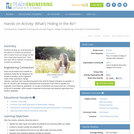
Students develop an understanding of the effects of invisible air pollutants with a rubber band and hanger air test and a bean plant experiment. They also learn about methods of reducing invisible air pollutants.
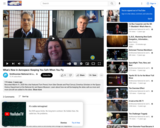
Learn about how we will be keeping the skies safe as more and more aircraft are added to the skies.